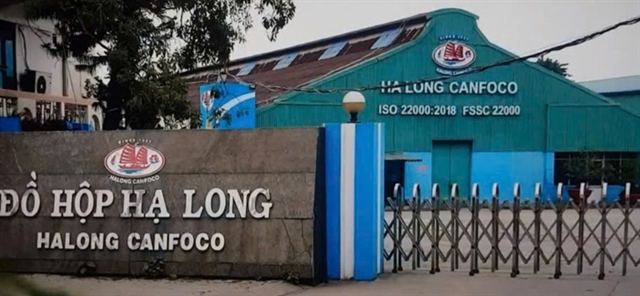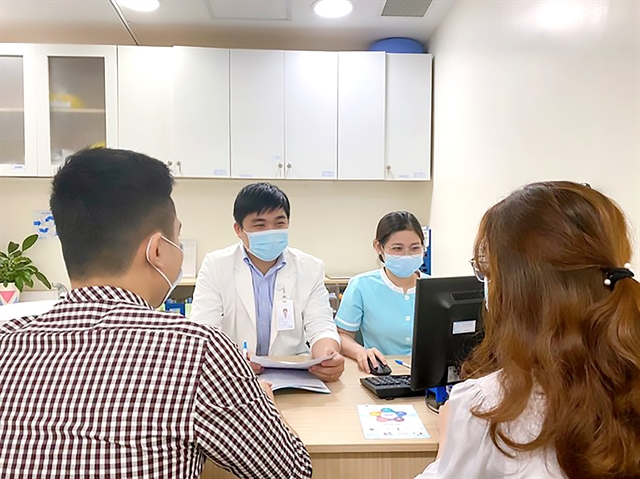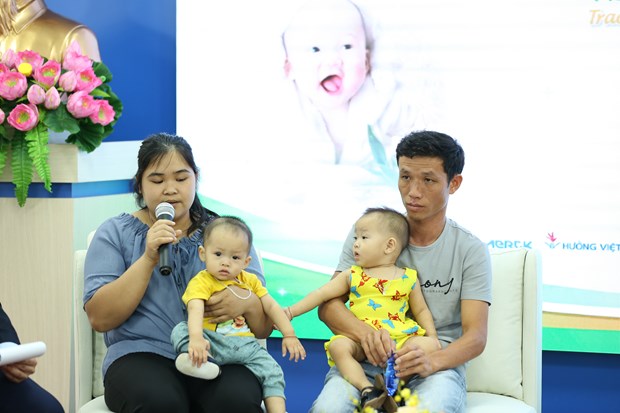 Society
Society

 |
| Doctor Lê Long Hồ, acting head of Mỹ Đức Hospital’s Mỹ Đức Phú Nhuận Fertility Support Department, gives infertility treatment counselling for patients at Mỹ Đức Hospital in HCM City. Photo courtesy of the hospital |
HÀ NỘI — Việt Nam has emerged as a beacon in infertility treatment, offering both domestic and foreign patients access to modern technology, high success rates, and cost-effective solutions, according to health experts.
Furthermore, compared to other regions and countries, the cost of infertility treatment in Việt Nam is significantly lower.
A 35-year-old French-Vietnamese woman, who wished to be anonymous, was desperate for a baby after years of marriage.
In 2019, she and her husband decided to return to Việt Nam for infertility treatment in a hospital in HCM City.
Their first attempt at performing intrauterine insemination (IUI), a fertility treatment where sperm were placed directly into a woman’s uterus, failed.
In 2022, the couple tried again, fearing they were running out of time to be parents.
On this second try at Mỹ Đức Hospital, they were advised to apply in vitro fertilization (IVF). This is the most effective form of assisted reproductive technology in which eggs are combined with sperm outside the couple’s body in a lab in five steps, including ovarian stimulation, egg retrieval, sperm retrieval, fertilisation and embryo transfer.
Their efforts paid off. The woman is 26 weeks pregnant and has some frozen embryos for her next pregnancy.
IVF technology in Việt Nam is very good. My process was painless and went smoothly. We were surprised to see it happen quite quickly, she told Người Lao Động (Labourers) online newspaper.
“The cost of performing IVF in Việt Nam is lower than in Singapore or Thailand. I want to thank the hospital's medical staff for making our dream of having a child come true,” she said.
N.M.L in central Thanh Hoá Province had experienced an uncertain journey to become a father after six years of travelling around to have infertility treatment.
The man suffered from Klinefelter syndrome, a genetic disorder in men that leads to low or no sperm counts.
Đinh Hữu Việt, head of Andrology and Fertility Hospital of Hanoi’s Department of Andrology, said in the past, most of these cases had to accept child adoption or ask for sperm donors.
But the application of Microscopic testicular sperm extraction (MicroTESE) is a procedure that takes sperm directly from the testicular tissue of the man's reproductive system.
The doctors spent hours searching for sperm using an operating microscope and implemented IVF for the couple.
Việt said MicroTESE is currently considered one of the great advances in assisted reproduction treatment. This method is indicated for male infertility due to testicular atrophy, Sertoli syndrome, and mid-sperm spermatogenesis syndrome.
Advanced technology
In addition to IVF and MicroTESE, many advanced infertility treatments have been applied at medical facilities, such as artificial insemination (IUI), intracytoplasmic sperm injection (ICSI), and autologous platelet-rich plasma (PRP).
Modern treatment regimens in embryo culture and embryo storage have increased the success rate of an IVF cycle up to 60-70 per cent.
 |
| A newborn baby under special treatment at A Thái Nguyên General Hospital, which provides assisted reproduction such as IVF and MicroTESE. VNA/VNS Photo Hoàng Nguyên |
Lý Thái Lộc, head of Hùng Vương Hospital’s Infertility Department in HCM City, said Việt Nam had begun research on artificial intelligence in embryo diagnosis and monitoring.
“In this field, we are still slower than the world because Việt Nam's artificial intelligence foundation is not high," Lộc said. "However, with the development of computer science in Việt Nam, this technique will develop stronger and bring more practical achievement to infertile patients in the future."
Hùng Vương Hospital receives between 50-60 cases from abroad for infertility treatment every year, despite COVID-19.
Hồ Sỹ Hùng, Deputy Director of the National Hospital of Obstetrics and Gynecology’s National Centre for Reproductive Support, assessed that Việt Nam’s techniques and procedures in assisted reproductive technology are not as good as those in developed countries, but are getting closer to many health facilities in the region.
“Developed countries have invested a lot of resources to research and develop new techniques in assisted reproduction so that they will be ahead of us. But the world is flat, so approaching, learning and applying these techniques is fast and convenient,” he said.
Hồ Mạnh Tường, Head of Mỹ Đức Hospital’s Fertility Support Department, said assisted reproductive technology in Việt Nam has developed very rapidly in the past ten years.
Currently, Việt Nam has successfully implemented all modern assisted reproductive techniques in the world. It is the country that performs the most IVF in the ASEAN region with the highest success rate but the lowest cost, he said.
Tường cited a number of techniques such as frozen embryo transfer and IVF without ovarian stimulation (IVM technique) as examples that Việt Nam is leading the region.
“Việt Nam is also the country with the most international scientific publications related to assisted reproductive technology in the ASEAN region. Many colleagues in the region and the world regularly visit IVF centres for expertise exchange,” he said.
 |
| A couple shares their story of taking an IVF course at the Andrology and Fertility Hospital of Hanoi. VNA/VNS Photo |
Potential top destination
Lê Long Hồ, acting head of Mỹ Đức Hospital’s Mỹ Đức Phú Nhuận Fertility Support Department, said previously an IVF course took about 10-12 days, using 15-20 injections to stimulate ovaries, preventing ovulation and causing oocyte maturation and 2-3 ultrasounds and blood tests.
Besides long treatment times, patients suffered multiple injections of ovarian stimulation, posing risks of many complications such as pain, ovarian torsion, and even death.
Hồ said the biphasic in vitro maturation (CAPA-IVM) technique, also known as IVF without ovarian stimulation, reduces treatment time to only eight days and lowers the treatment cost.
“The cost of performing IVF in Việt Nam is rather low compared to that in many countries in Southeast Asia and around the world," said Hồ. "Foreign patients coming to Việt Nam for treatment can save a portion of their costs. This is one of the important reasons why overseas Vietnamese are choosing to return home to perform IVF.”
However, he added, the cost remains quite high for domestic patients and is not covered by health insurance.
The cost of performing an IVF is up to US$25,000 in the US and about VNĐ250 million ($10,660) in Southeast Asia nations such as the Philippines, Singapore, and Thailand. Meanwhile, the cost in Việt Nam is only VNĐ70 million ($2,980).
At Hùng Vương Hospital, an IVF case only costs about VNĐ80-100 million with a pregnancy rate of 55-60 per cent and live birth rate of about 30 per cent. Meanwhile, the cost of IVF in developed countries is $10,000, with similar pregnancy and live birth rates.
Head of Mỹ Đức Hospital’s Fertility Support Department Tường also said that in recent years, more and more overseas Vietnamese and foreigners have come to Mỹ Đức Hospital to perform assisted reproductive techniques.
“Việt Nam has the potential to become a leading destination in Asia and the world for assisted reproductive techniques,” Tường said. – VNS




